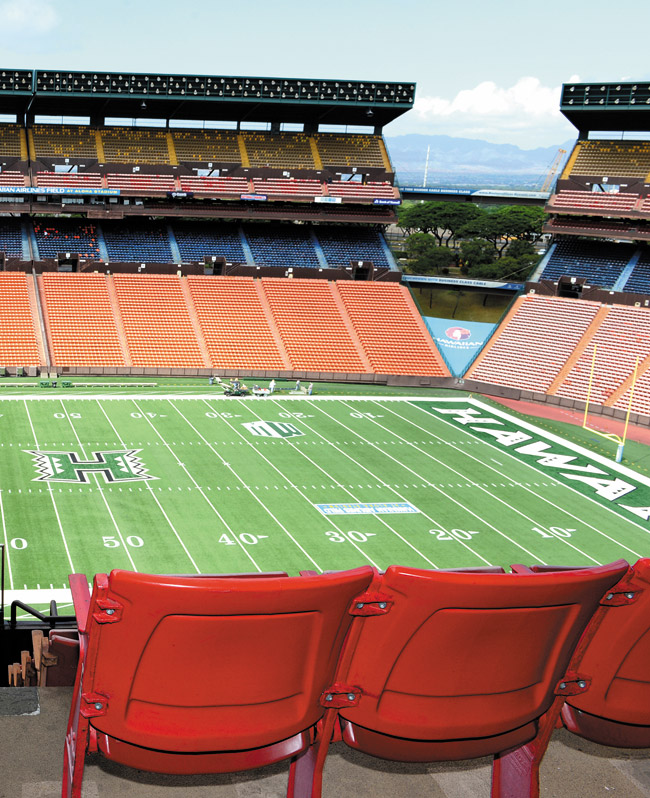Smaller Stadium A Sound Financial Plan

UH athletic director Ben Jay wants to close off the upper section of Aloha Stadium. Nathalie Walker photo
When UH athletics director Ben Jay notified the Board of Regents of a plan to close the upper rim of Aloha Stadium, an expected grumble swept through social media.
Chief among concerns was the displacement of season ticket holders and a further degradation of the university’s commitment to athletics. No doubt such a move, if taken, will create a few headaches, but the potential for greater benefit outweighs the challenges of moving a few people out of their $10-a-game seats.
The first thing we need to accept is that Aloha Stadium is a 35,000-seat stadium capable of expanding to 50,000. Collective memory is filled with numerous packed-tothe-rafters games, but memory rarely measures up to reality.
In the history of Aloha Stadium, UH has never sold out more than two games in any single season, and that has happened only six times and not since 2007. When big-name opponents come to play, or if the home team reaches a necessary level of success, it’s an easy matter to open additional seating to accommodate ticket buyers.
A smaller stadium just makes sense.
Because of its design and a naturally boisterous fan base, Aloha Stadium can get louder than many larger stadiums. But much of that game day atmosphere gets lost when 30,000 fans are dispersed in a space capable of holding 67 percent more people.
The closeness of seating will look better on television, which is the base of most athletic considerations, and make the game safer. Under the new plan, security personnel and HPD officers can be concentrated in a smaller area, making it easier to spot and respond to trouble, further enhancing the fan experience.
While it may sound strange, smaller stadiums can make more money than their larger counterparts.
It’s simple supply and demand economics. (Of course, demand is predicated on winning.) Jay has a fixed number of seats to sell from which he must draw enough revenue to fund a certain percentage of his athletic budget. When the number of seats is reduced it raises demand and therefore ticket prices, hopefully to a level higher than it had been under the current seating arrangement.
That shouldn’t be too hard. According to Jay, a mere 3,225 season tickets were sold this season in the upper-deck area that seats 15,000. Moving those ticket holders who have long called the upper level home will generate a fair amount of complaints, but fixed pricing isn’t a consumer right. To stay solvent, UH has to find dollars where none previously had existed.
Jay has said fans who relocate will not have to pay the premium seat price if their new seats fall into those areas. For a group of ticket buyers used to purchasing seats that are below typical market value, that’s a fair deal that’s not going to get any better.
A second way to generate more revenue is by creating more ad space. To avoid the look of a half-empty stadium, the Stadium Authority will cover those seats with tarps.
Those tarps, limited to the upper-most yellow section, can be imprinted with corporate logos to generate funds that can be split between the athletic department and Stadium Authority. Separate smaller tarps in the “Red” section can be removed quickly to provide an additional 2,400 seats.
What I had thought was a unique recommendation has turned into anything but surprising. It turns out Jay and stadium manager Scott Chan had discussed the idea – minus a split of the cash – during the UH/Army game.
Any decision is months off, but Jay says if the coverup happens and if ads are placed, he wants a cut for the department.
He should get it. Under the current agreement, UH owns the field and gets the revenue from all advertising at that level. The rest of the signage belongs to the stadium. Since this would be new revenue, Aloha Stadium wouldn’t lose income, making a new revenue split a no brainer.
In addition to raising income for both parties, the tarps could be used to create a ring of honor celebrating former UH athletes. Outside of the largely unnoticed Circle of Honor plaques at Stan Sheriff Center and the retired numbers of Derek Tatsuno and Les Murakami inside the stadium that bears the former coach’s name, UH has done a poor job recording and promoting its history.
This would correct that error. Honoring the university’s greatest athletes, coaches and administrators atop its most iconic venue would celebrate and preserve the past.
smurray@midweek.com
Twitter @SteveMurray84





